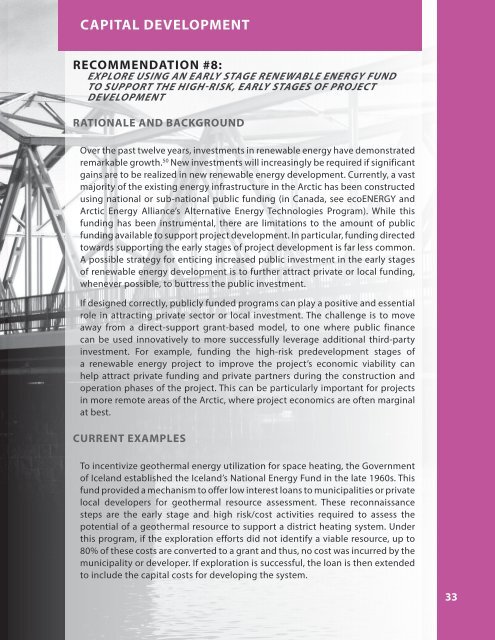DEVELOPING RENEWABLE ENERGY IN ARCTIC AND SUB-ARCTIC REGIONS AND COMMUNITIES
FulbrightArcRenewableEnergy
FulbrightArcRenewableEnergy
You also want an ePaper? Increase the reach of your titles
YUMPU automatically turns print PDFs into web optimized ePapers that Google loves.
CAPITAL DEVELOPMENT<br />
RECOMMENDATION #8:<br />
EXPLORE US<strong>IN</strong>G AN EARLY STAGE <strong>RENEWABLE</strong> <strong>ENERGY</strong> FUND<br />
TO SUPPORT THE HIGH-RISK, EARLY STAGES OF PROJECT<br />
DEVELOPMENT<br />
RATIONALE <strong>AND</strong> BACKGROUND<br />
Over the past twelve years, investments in renewable energy have demonstrated<br />
remarkable growth. 50 New investments will increasingly be required if significant<br />
gains are to be realized in new renewable energy development. Currently, a vast<br />
majority of the existing energy infrastructure in the Arctic has been constructed<br />
using national or sub-national public funding (in Canada, see eco<strong>ENERGY</strong> and<br />
Arctic Energy Alliance’s Alternative Energy Technologies Program). While this<br />
funding has been instrumental, there are limitations to the amount of public<br />
funding available to support project development. In particular, funding directed<br />
towards supporting the early stages of project development is far less common.<br />
A possible strategy for enticing increased public investment in the early stages<br />
of renewable energy development is to further attract private or local funding,<br />
whenever possible, to buttress the public investment.<br />
If designed correctly, publicly funded programs can play a positive and essential<br />
role in attracting private sector or local investment. The challenge is to move<br />
away from a direct-support grant-based model, to one where public finance<br />
can be used innovatively to more successfully leverage additional third-party<br />
investment. For example, funding the high-risk predevelopment stages of<br />
a renewable energy project to improve the project’s economic viability can<br />
help attract private funding and private partners during the construction and<br />
operation phases of the project. This can be particularly important for projects<br />
in more remote areas of the Arctic, where project economics are often marginal<br />
at best.<br />
CURRENT EXAMPLES<br />
To incentivize geothermal energy utilization for space heating, the Government<br />
of Iceland established the Iceland’s National Energy Fund in the late 1960s. This<br />
fund provided a mechanism to offer low interest loans to municipalities or private<br />
local developers for geothermal resource assessment. These reconnaissance<br />
steps are the early stage and high risk/cost activities required to assess the<br />
potential of a geothermal resource to support a district heating system. Under<br />
this program, if the exploration efforts did not identify a viable resource, up to<br />
80% of these costs are converted to a grant and thus, no cost was incurred by the<br />
municipality or developer. If exploration is successful, the loan is then extended<br />
to include the capital costs for developing the system.<br />
33


